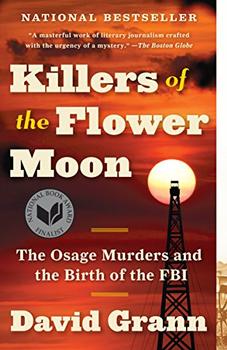Summary | Excerpt | Reviews | Beyond the Book | Read-Alikes | Genres & Themes | Author Bio

The Osage Murders and the Birth of the FBI
by David GrannThis article relates to Killers of the Flower Moon
What do the following people have in common? James Earl Ray, who assassinated Martin Luther King; Former NFL star quarterback Michael Vick; and Carl Panzram, a confessed serial killer who committed more than 20 murders.
If you have no idea, then congratulations – you've led a life of moral rectitude. Or, at the very least, you've never spent any time at Leavenworth Federal Penitentiary, perhaps the most notorious prison in America and the one-time home of each of those mentioned above. The prison figures prominently in David Grann's Killers of the Flower Moon. As one prison-related website notes, "Its guest list reads like a who's-who of infamy, full of swindlers, gangsters, murderers and monsters."

The prison gets its name from Leavenworth, Kansas, where it's been receiving inmates since 1903, making it one of the longest operating penitentiaries in the nation. For most of its existence, Leavenworth was the largest maximum security facility in the country. In 2005, the prison's status was changed from "maximum" to "medium" security, though it continues to house inmates.
In Killers of the Flower Moon, Leavenworth ends up being the destination of the man convicted of orchestrating a string of murders of Osage Indians. In an ironic twist, the
intrepid investigator who cracked the case, an FBI agent named Thomas White, was rewarded with the position of warden of Leavenworth. "The oldest federal penitentiary, it was then considered one of the country's most dreaded places to be incarcerated. There had been allegations of corruption, and the assistant attorney general had told [J. Edgar] Hoover that White was ideal for the job," notes Grann, whose description of the hellish conditions of the place makes clear why it was so dreaded:
The challenges of managing the prison – which was designed to hold twelve hundred inmates but instead had three times that number – were overwhelming. In the summer, the temperatures rose inside as high as 115 degrees, which is why prisoners would call Leavenworth the Hot House. One August day in 1929, when it was so nightmarishly hot that the milk in the prison's kitchen soured, a riot erupted in the mess hall.
The prison is sometimes popularly confused with the U.S. Disciplinary Barracks at Fort Leavenworth, an Army base in the same city – and itself infamous for the severity of its conditions in certain wards. As an Army News Service article reports, of the base: "The special housing unit is reserved for inmates who could be locked up 23 hours a day. Food is slid into cells through narrow slots, and a small window at the foot of each door lets the guards, known within the USDB as correctional specialists, chain inmates' ankles before they're escorted out for showers or fresh air. Every time one of these inmates moves, two or three staff members are with them."
The website of Leavenworth Penitentiary suggests a modern, well-run facility, with information on visiting hours, resources for sentenced inmates, and "How to send things here." The prison is one of the "attractions" mentioned on the home page of the Leavenworth tourist bureau, and is included as part of a guided tour of the city, though the site reassuringly reminds visitors that the tour of "the 'Big House' which is the United States Federal Penitentiary—is drive-by only!"
Picture of Leavenworth penitentiary by Americasroof
Filed under Places, Cultures & Identities
![]() This "beyond the book article" relates to Killers of the Flower Moon. It originally ran in April 2017 and has been updated for the
April 2018 paperback edition.
Go to magazine.
This "beyond the book article" relates to Killers of the Flower Moon. It originally ran in April 2017 and has been updated for the
April 2018 paperback edition.
Go to magazine.
Your guide toexceptional books
BookBrowse seeks out and recommends the best in contemporary fiction and nonfiction—books that not only engage and entertain but also deepen our understanding of ourselves and the world around us.